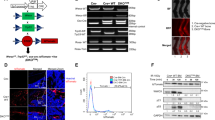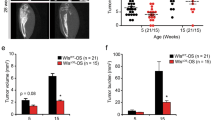Abstract
The development of cancer is due to the growth and proliferation of transformed normal cells. Recent evidence suggests that the nature of oncogenic stress and the state of the cell of origin critically affect both tumorigenic activity and tumor histological type. However, this mechanistic relationship in mesenchymal tumors is currently largely unexplored. To clarify these issues, we established a mouse osteosarcoma (OS) model through overexpression of c-MYC in bone marrow stromal cells (BMSCs) derived from Ink4a/Arf (−/−) mice. Single-cell cloning revealed that c-MYC-expressing BMSCs are composed of two distinctly different clones: highly tumorigenic cells, similar to bipotent-committed osteochondral progenitor cells, and low-tumorigenic tripotent cells, similar to mesenchymal stem cells (MSCs). It is noteworthy that both bipotent and tripotent cells were capable of generating histologically similar, lethal OS, suggesting that both committed progenitor cells and MSCs can become OS cells of origin. Shifting mesenchymal differentiation by depleting PPARγ in tripotent MSC-like cells and overexpressing PPARγ in bipotent cells affected cell proliferation and tumorigenic activity. Our findings indicate that differentiation potential has a key role in OS tumorigenic activity, and that the suppression of adipogenic ability is a critical factor for the development of OS.
This is a preview of subscription content, access via your institution
Access options
Subscribe to this journal
Receive 50 print issues and online access
$259.00 per year
only $5.18 per issue
Buy this article
- Purchase on Springer Link
- Instant access to full article PDF
Prices may be subject to local taxes which are calculated during checkout







Similar content being viewed by others
References
Adhikary S, Eilers M . (2005). Transcriptional regulation and transformation by MYC proteins. Nat Rev Mol Cell Biol 6: 635–645.
Barrios C, Castresana JS, Kreicbergs A . (1994). Clinicopathologic correlations and short-term prognosis in musculoskeletal sarcoma with c-myc oncogene amplification. Am J Clin Oncol 17: 273–276.
Benassi MS, Molendini L, Gamberi G, Magagnoli G, Ragazzini P, Gobbi GA et al. (2001). Involvement of INK4A gene products in the pathogenesis and development of human osteosarcoma. Cancer 92: 3062–3067.
Berman SD, Calo E, Landman AS, Danielian PS, Miller ES, West JC et al. (2008). Metastatic osteosarcoma induced by inactivation of Rb and p53 in the osteoblast lineage. Proc Natl Acad Sci USA 105: 11851–11856.
Bonnet D, Dick JE . (1997). Human acute myeloid leukemia is organized as a hierarchy that originates from a primitive hematopoietic cell. Nature Med 3: 730–737.
Brantley-Sieders DM, Zhuang G, Hicks D, Fang WB, Hwang Y, Cates JMM et al. (2008). The receptor tyrosine kinase EphA2 promotes mammary adenocarcinoma tumorigenesis and metastatic progression in mice by amplifying ErbB2 signaling. J Clin Invest 118: 64–78.
Cole MF, Johnstone SE, Newman JJ, Kagey MH, Young RA . (2008). Tcf3 is an integral component of the core regulatory circuitry of embryonic stem cells. Genes Dev 22: 746–755.
Collado M, Blasco MA, Serrano M . (2007). Cellular senescence in cancer and aging. Cell 130: 223–233.
Corless CL, Fletcher JA, Heinrich MC . (2004). Biology of gastrointestinal stromal tumors. J Clin Oncol 22: 3813–3825.
Cozzio A, Passegue E, Ayton PM, Karsunky H, Cleary ML, Weissman IL . (2003). Similar MLL-associated leukemias arising from self-renewing stem cells and short-lived myeloid progenitors. Genes Dev 17: 3029–3035.
Daluiski A, Engstrand T, Bahamonde ME, Gamer LW, Agius E, Stevenson SL et al. (2001). Bone morphogenic protein-3 is a negative regulator of bone density. Nat Genet 27: 84–88.
Dannenberg AJ, Altorki NK, Boyle JO, Dang C, Howe LR, Weksler BB et al. (2001). Cyclo-oxygenase 2: a pharmacological target for the prevention of cancer. Lancet Oncol 2: 544–551.
Dass CR, Ek ET, Contreras KG, Choong PF . (2006). A novel orthotopic murine model provides insight into cellular and molecular characteristics contributing to human osteosarcoma. Clin Exp Metastasis 23: 367–380.
Eisen MB, Spellman PT, Brown PO, Botstein D . (1998). Cluster analysis and display of genome-wide expression patterns. Proc Natl Acad Sci USA 95: 14863–14868.
Engin F, Yao Z, Yang T, Zhou G, Bertin T, Jiang MM et al. (2008). Dimorphic effects of Notch signaling in bone homeostasis. Nat Med 14: 299–305.
Fletcher CDM, Unni KK, Mertens F (ed) (2002). Osteogenic Tumours: WHO Classification Tumours of Soft Tissue and Bone. IARC Press: Lyon.
Fujino R, Tanaka K, Morimatsu M, Tamura K, Kogo H, Hara T . (2006). Spermatogonial cell-mediated activation of an IκBɛ-independent nuclear factor-κB pathway in Sertoli cells induces transcription of the Lipocalin-2 gene. Mol Endocrinol 20: 904–915.
Gamberi G, Benassi MS, Bohling T, Ragazzini P, Molendini L, Sollazzo MR et al. (1998). C-myc and c-fos in human osteosarcoma: prognostic value of mRNA and protein expression. Oncology 55: 556–563.
Gregory CA, Prockop DJ, Spees JL . (2005). Non-hematopoietic bone marrow stem cells: molecular control of expansion and differentiation. Exp Cell Res 306: 330–335.
Haydon RC, Zhou L, Feng T, Breyer B, Cheng H, Jiang W et al. (2002). Nuclear receptor agonist as potential differentiation therapy agents for human osteosarcoma. Clin Cancer Res 8: 1288–1294.
Hong JH, Hwang ES, McManus MT, Amsterdam A, Tian Y, Kalmukova R et al. (2005). TAZ, a transcriptional modulator of mesenchymal stem cell differentiation. Science 309: 1074–1078.
Huntly BJP, Shigematsu H, Deguchi K, Lee BH, Mizuno S, Duclos N et al. (2004). MOZ-TIF2, but not BCR-ABL, confers properties of leukemic stem cells to committed murine hematopoietic progenitors. Cancer Cell 6: 587–596.
Janzen V, Forkert R, Fleming HE, Saito Y, Waring MT, Dombkowski DM et al. (2006). Stem-cell aging modified by the cyclin-dependent kinase inhibitor p16INK4a. Nature 443: 421–426.
Kim KJ, Li B, Winer J, Armanini M, Gillett N, Phillips HS et al. (1993). Inhibition of vascular endothelial growth factor-induced angiogenesis suppresses tumor growth in vivo. Nature 362: 841–844.
Kitamura T, Koshino Y, Shibata F, Oki T, Nakajima H, Nosaka T et al. (2003). Retrovirus-mediated gene transfer and expression cloning: powerful tools in functional genomics. Exp Hematol 31: 1007–1014.
Koeffler HP . (2003). Peroxisome proliferator-activated receptor γ and cancers. Clin Cancer Res 9: 1–9.
Krivtsov AV, Twomey D, Feng Z, Stubbs MC, Wang Y, Faber J et al. (2006). Transformation from committed progenitor to leukemia stem cell initiated by MLL-AF9. Nature 442: 818–822.
Lee AY, He B, You L, Dadfarmay S, Xu Z, Mazieres J et al. (2004). Expression of the secreted frizzled-related protein gene family is downregulated in human mesothelioma. Oncogene 23: 6672–6676.
Li H, Marijanovic I, Kronenberg MS, Erceg I, Stover ML, Velonis D et al. (2008). Expression and function of Dlx genes in the osteoblast lineage. Dev Biol 316: 458–470.
Li N, Yang R, Zhang W, Dorfman H, Rao P, Gorlick R et al. (2009). Genetically transforming human mesenchymal stem cells to sarcomas. Cancer 115: 4795–4806.
Lopez-Guerrero JA, Lopez-Gines C, Pellin A, Carda C, Llombart-Bosch A . (2004). Deregulation of the G1 to S-phase cell cycle checkpoint is involved in the pathogenesis of human osteosarcoma. Diagn Mol Pathol 13: 81–91.
Luo G, Ducy P, McKee MD, Pinero GJ, Loyer E, Behringer RR et al. (1997). Spontaneous calcification of arteries and cartilage in mice lacking matrix GLA protein. Nature 386: 78–81.
Mandal D, Srivastava A, Mahlum E, Desai D, Maran A, Yaszemski M et al. (2007). Severe suppression of Frzb/sFRP3 transcription in osteogenic sarcoma. Gene 386: 131–138.
Miller SFC, Summerhurst K, Runker AE, Kerjan G, Friedel RH, Chedotal A et al. (2007). Expression of Plxdc2/TEM7R in the developing nervous system of the mouse. Gene Expr Patterns 7: 635–644.
Molofsky AV, Slutsky SG, Joseph NM, He S, Pardal R, Krishnamurthy J et al. (2006). Increasing p16INK4a expression decreases forebrain progenitors and neurogenesis during ageing. Nature 443: 448–452.
Pardal R, Clarke MF, Morrison SJ . (2003). Applying the principles of stem-cell biology to cancer. Nat Rev Cancer 3: 895–902.
Parker LH, Schmidt M, Jin SW, Gray AM, Beis D, Pham T et al. (2004). The endothelial-cell-derived secreted factor Egfl7 regulates vascular tube formation. Nature 428: 754–758.
Peister A, Mellad JA, Larson BL, Hall BM, Gibson LF, Prockop DJ . (2004). Adult stem cells from bone marrow (MSCs) isolated from different strains of inbred mice vary in surface epitopes, rates of proliferation, and differentiation potential. Blood 103: 1662–1668.
Ponten J, Saksela E . (1967). Two established in vitro cell lines from human mesenchymal tumors. Int J Cancer 2: 434–447.
Reya T, Morrison SJ, Clarke MF, Weissman IL . (2001). Stem cells, cancer, and cancer stem cells. Nature 414: 105–111.
Riggi N, Cironi L, Provero P, Suza ML, Stehle JC, Baumer K et al. (2006). Expression of the FUS-CHOP fusion protein in primary mesenchymal progenitor cells gives rise to a model of myxoid liposarcama. Cancer Res 66: 7016–7023.
Rosen ED, Walkey CJ, Puigserver P, Spiegelman BM . (2000). Transcriptional regulation of adipogenesis. Genes Dev 14: 1293–1307.
Shibata KR, Aoyama T, Yasuko S, Fukiage K, Otsuka S, Furu M et al. (2007). Expression of the p16INK4a gene is associated closely with senescence of human mesenchymal stem cells and is potentially silenced by DNA methylation during in vitro expansion. Stem Cells 25: 2371–2382.
Thomas G, Moffatt P, Salois P, Gaumond MH, Gingras R, Godin E et al. (2003). Osteocrin, a novel bone-specific secreted protein that modulates the osteoblast phenotype. J Biol Chem 278: 50563–50571.
Torres-Vazquez J, Gitler AD, Fraser SD, Berk JD, Pham VN, Fishman MC et al. (2004). Semaphorin-plexin signaling guides patterning of the developing vasculature. Dev Cell 7: 117–123.
van der Horst G, van der Werf SM, Farih-Sips H, van Bezooijen RL, Lowik CW, Karperien M . (2005). Downregulation of Wnt signaling by increased expression of Dickkopf-1 and -2 is a prerequisite for late-stage osteoblast differentiation of KS483 cells. J Bone Miner Res 20: 1867–1877.
Walkley CR, Qudsi R, Sankaran VG, Perry JA, Gostissa M, Roth SI et al. (2008). Conditional mouse osteosarcoma, dependent on p53 loss and potentiated by loss of Rb, mimics the human disease. Genes Dev 22: 1662–1676.
Wang MM, Reed RR . (1993). Molecular cloning of the olfactory neuronal transcription factor Olf-1 by genetic selection in yeast. Nature 364: 121–126.
Wu Z, Rosen ED, Brun R, Hauser S, Adelmant G, Troy AE et al. (1999). Cross-regulation of C/EBPα and PPARγ controls the transcriptional pathway of adipogenesis and insulin sensitivity. Mol Cell 3: 151–158.
Zang X, Thompson RH, Al-Ahmadie HA, Serio AM, Reuter VE, Eastham JA et al. (2007). B7-H3 and B7x are highly expressed in human prostate cancer and associated with disease spread and poor outcome. Proc Natl Acad Sci USA 104: 19458–19463.
Acknowledgements
We are grateful to I Ishimatsu and N Suzuki for technical assistance. We thank K Arai for secretarial assistance. This work was partly supported by grants from the Ministry of Education, Science, Sports, and Culture of Japan (TS and HS) and a grant from the National Institute of Biomedical Innovation, Japan (HS).
Author information
Authors and Affiliations
Corresponding author
Ethics declarations
Competing interests
The authors declare no conflict of interest.
Additional information
Supplementary Information accompanies the paper on the Oncogene website
Rights and permissions
About this article
Cite this article
Shimizu, T., Ishikawa, T., Sugihara, E. et al. c-MYC overexpression with loss of Ink4a/Arf transforms bone marrow stromal cells into osteosarcoma accompanied by loss of adipogenesis. Oncogene 29, 5687–5699 (2010). https://doi.org/10.1038/onc.2010.312
Received:
Revised:
Accepted:
Published:
Issue Date:
DOI: https://doi.org/10.1038/onc.2010.312
Keywords
This article is cited by
-
Cancer aggravation due to persistent pain signals with the increased expression of pain-related mediators in sensory neurons of tumor-bearing mice
Molecular Brain (2023)
-
C/ebpα represses the oncogenic Runx3–Myc axis in p53-deficient osteosarcoma development
Oncogene (2023)
-
The IL-17-IL-17RA axis is required to promote osteosarcoma progression in mice
Scientific Reports (2023)
-
Utilization of a novel Sendai virus vector in ex vivo gene therapy for hemophilia A
International Journal of Hematology (2021)
-
In vitro cellular and proteome assays identify Wnt pathway and CDKN2A-regulated senescence affected in mesenchymal stem cells from mice after a chronic LD gamma irradiation in utero
Radiation and Environmental Biophysics (2021)



